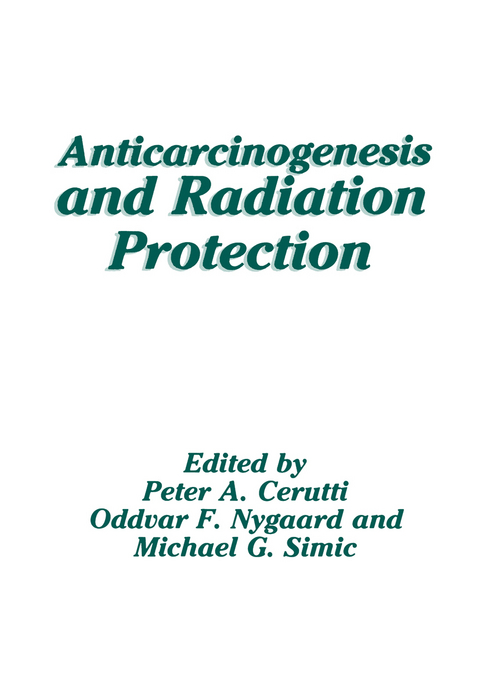
Anticarcinogenesis and Radiation Protection
Springer-Verlag New York Inc.
978-1-4615-6464-5 (ISBN)
Free Radical Mechanisms.- The Involvement of Free Radicals in Chemical Carcinogenesis.- Autoxidation and Enzymatic Oxidation of Unsaturated Lipids.- Electron vs. H-Atom Transfer in Chemical Repair.- Radiation Induced Reactions of Glutathione with Oxygen and Their Possible Role in Biological Systems.- Potential Limitation to Hydrogen Atom Donation as a Mechanism of Repair in Chemical Models of Radiation Damage.- Mechanisms of Inactivation of Oxygen Species by Carotenoids.- Inhibition of Autoxidation by Vitamin E and Bilirubin.- Oxygen Species in Carcinogenesis.- The Role of Active Oxygen and the Metabolism of Arachidonic Acid in The Formation of Clastogenic Factor by Human Monocytes.- Clastogenic Factors, A Link Between Chronic Inflammation and Carcinogenesis.- Role of Eicosanoids in Tumor Cell-Platelet-Endothelial Cell Interactions.- The Involvement of Peroxyl Free Radicals in Tumor Initiation and Promotion.- Amplification of Tissue Peroxides in Disease.- Peroxisome Proliferation-Related Oxidative Stress and Hepato-Carcinogenesis.- Hydroxyl Free Radical Mediated Strand Breaks in PBR322 Plasmid DNA.- Radiation-Like Modification of DNA and H2O2 Formation by Activated Human Polymorphonuclear Leukocytes (PMNs).- Mitochondrial DNA Damage During Mitochondrial Lipid Peroxidation.- Mitigation of Singlet Oxygen (1?gO2) Damage in Biological Systems.- Reactive Oxygen Species are Mutagenic to Mammalian Cells.- Enzymatic Repair of DNA Damage.- The Expression of Bacterial DNA Alkylation Repair Enzymes in Mer Human Cells.- DRPase, A New Activity in the DNA Base Excision Repair Pathway.- Mechanism of Action of Exonuclease III From Escherichia coli.- The Isolation and Preliminary Characterization of Endonuclease VIII from Escherichia coli.- Incorporation of Dihydrothymidine and itsTriphosphate During DNA Replication: An Implication for the Biological Consequence of Thymine C5-C6 Bond Saturation.- Oxidative Damage: DNA Repair and Inducible Resistance.- 5-Hydroxymethyluracil in Cellular DNA is Repaired and Sensitizes Cells to Inhibitors of Poly(ADP-Ribose) Synthesis.- Metabolic Protection Against Rapid Death Induced by High Level DNA Damage.- Tumor Promotion and Progression.- Tumor Promotion: A Problem of Differential Responses of Normal and Neoplastic Cells to Trophic Stimuli.- Implication of Superoxide Radical Anion in Promotion of Neoplastic Transformation in Mouse JB6 Cells by TPA.- Expression of Oxidant Stress-Related Genes in Tumor Promotion of Mouse Epidermal Cells JB6.- Activation of Organic Hydroperoxide Tumor Promoters to Free Radicals in Target Cells.- In Vivo Stimulation of Oxy Radicals by Mouse Skin Tumor Promoters.- UVB Prevention of Mouse Skin Tumor Induction by the Initiation-Promotion Protocol.- A Possible Role for Free Radicals in Tumor Progression.- Differential Effects of 12-0-Tetradecanoylphorbol-13-acetate (TPA) on Normal, Initiated and Transformed Cells of a Single Mouse Keratinocyte Lineage.- Oncogenes and Malignant Transformation of Human Keratinocytes.- Chemoprevention.- Nucleophiles as Anticarcinogens.- Protection from N-Nitrosodimethylamine Mediated Liver Damage by Indole-3-Carbinol, and Correlation with Nucleophilic Index Value.- Ozone Carcinogenesis and Co-Carcinogenesis and Its Prevention.- Exercise Training Effects on Mitochondrial Enzyme Activity, Ubiquinones and Vitamin E.- Cancer Mortality Inversely Related to Plasma Levels of Antioxidant Vitamins.- Beta-Carotene and Chemoprevention of Cancer.- Cancer Chemoprevention with Vitamin A and Beta-Carotene in Populations at High-Risk for Lung Cancer.- Anticarcinogenic Actions of Protease Inhibitors.- Possible Mechanisms of Action of the Anticarcinogenic Protease Inhibitors.- Dietary Choline Deficiency as a New Model to Study the Possible Role of Free Radicals in Acute Cell Injury and in Carcinogenesis.- Inhibition of Genotoxicity by Diallyl Sulfide and Structural Analogues.- Physiologic Anticarcinogenesis. Effects of Stable Strontium on Metastatic Bone Disease.- Radiation Damage and Protection.- Radiation vs Chemical Damage to DNA.- Radon-Induced Transformation.- Radiation-Induced Neoplastic Transformation of Human Cell Hybrids.- Multiple Oncogene Activation in a Radiation Carcinogenesis Model.- Radiation and Asbestos Fibers: Interaction and Possible Mechanism.- Role of Peroxidase in Stimulation of the Pentose Cycle of A549 Cells by Aerobic Irradiation.- Toxicity and Radioprotective Efficacy of Bis (3, 5-Diisopropylsalicylato) Copper II and CuCl2.- Thiols as Anticarcinogens And Radioprotectors.- Modulation of Glutathione Levels and Metabolism.- Inhibition of Mutagenesis and Carcinogenesis by N-Acetylcysteine.- Protective Effects of Thiols on Carcinogenesis Induced in Rats by 2-Acetylaminofluorene.- The Role of Thiols in Response to Radiation and Drugs.- The Role of Modification of DNA Damage in the Radioprotective Action of Aminothiols.- Radioprotection in Rat Spinal Cord with WR2721, WR77913 and WR3689 Following Cerebral Lateral Ventricular or Intracisternal Administration.- Production and Characterization of Monoclonal Antibodies to Thiol-Modified Glutathione.- Cancer Therapy.- Induction of Differential Hypoxia in Tissues and Its Implications for Therapy.- Radioprotection In Vivo: Cellular Heterogeneity and Fractionation.- Pharmacological Interference with DNA Repair.- DNA Strand Scission by Activated Bleomycin Group Antibiotics.- Prospects for Liposomes as Drug Carriers.- The Inhibitory Effect of Parvovirus H-1 on Cultured Human Cancer Cells or Transformed Cells.- Biological Response Modifiers.- Evaluation of Immunomodulatory and Therapeutic Properties of Biological Response Modifiers: A Comparison of Preclinical and Clinical Studies.- Circumvention of Biologic Diversity of Cancer Metastasis.- Comparison of Therapeutic Potential of Cytokines.- Clinical Trials Using Monoclonal Antibodies.- Chemoprophylaxis by Interferons or Inducers Against Chemical Carcinogenesis.
| Zusatzinfo | 72 Illustrations, black and white; XIV, 510 p. 72 illus. |
|---|---|
| Verlagsort | New York, NY |
| Sprache | englisch |
| Maße | 178 x 254 mm |
| Themenwelt | Medizin / Pharmazie ► Medizinische Fachgebiete ► Onkologie |
| Naturwissenschaften ► Biologie ► Ökologie / Naturschutz | |
| Naturwissenschaften ► Physik / Astronomie ► Angewandte Physik | |
| Technik | |
| ISBN-10 | 1-4615-6464-6 / 1461564646 |
| ISBN-13 | 978-1-4615-6464-5 / 9781461564645 |
| Zustand | Neuware |
| Haben Sie eine Frage zum Produkt? |
aus dem Bereich


